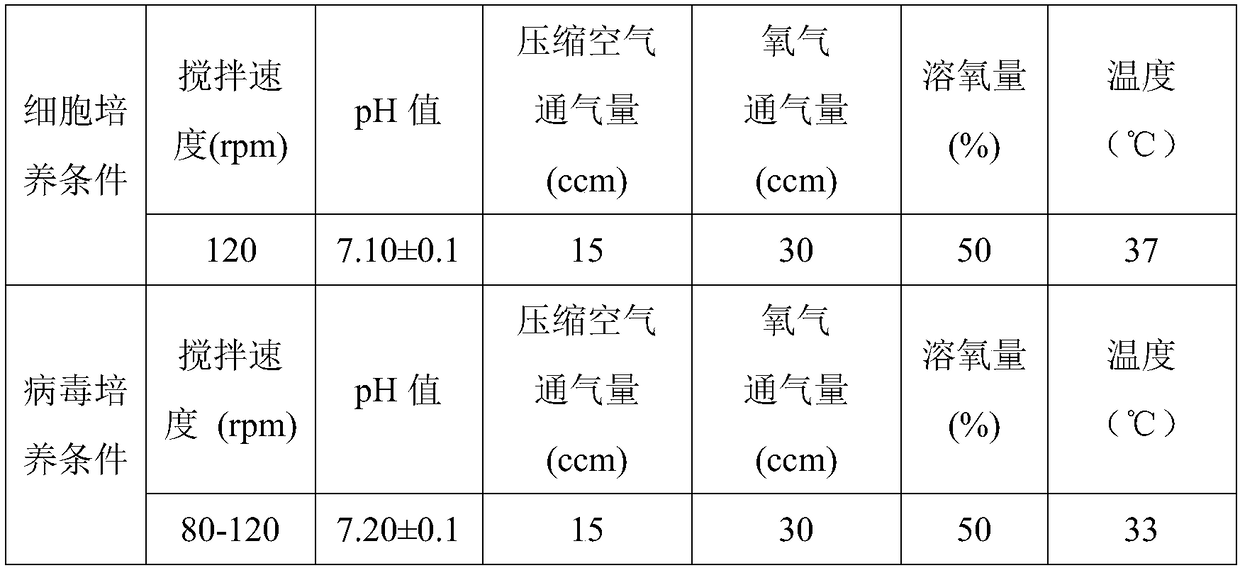Method for suspension culture of Newcastle disease virus (NDV) by using full-suspension passage cell line
A technology of Newcastle disease virus and subculture cells, which is applied in the field of veterinary biological products, can solve the problem of inability to guarantee the source of chicken embryos, the consistency of maternal antibody levels of breeds, incomplete autoclaving of embryo body waste, and inability to ensure the stable effect of vaccines To achieve the effect of improving virus titer and vaccine titer, overcoming the shortage of chicken embryo supply, good economic benefits and application prospects
- Summary
- Abstract
- Description
- Claims
- Application Information
AI Technical Summary
Problems solved by technology
Method used
Image
Examples
Embodiment 1
[0040] The cultivation method of embodiment 1 Newcastle disease virus is as follows:
[0041] Step 1: Use the second-stage culture method to press 10 -2 Newcastle disease virus was inoculated at MOI in the whole suspension cell line EB66 cells, and the cells were placed at 37°C and 5% CO after inoculation. 2 , Adsorption culture in an incubator with orbital shaker speed of 120rpm for 1h, after completion of adsorption culture, add fresh production medium twice the volume of the original growth medium, and place at 33°C, 5% CO 2 1. Continue culturing in an incubator with an orbital shaker rotating at 120rpm. On the 0th, 1st, 2nd, and 3rd day after inoculation, 1 mg / L TPCK trypsin was added. Sampling every 12h for EID 50 detection. Harvest the virus at the time when the virus titer is the highest as the seed virus for the next generation of domestication;
[0042] Step 2: Freeze-thaw and centrifuge the seed poison harvested in step 1 repeatedly for 3 times, and repeat the m...
Embodiment 2-6
[0048] The culture method of embodiment 2-6 Newcastle disease virus is as follows:
[0049] Using the second-stage culture method, the Newcastle disease virus was inoculated into the whole suspension cell line EB66 cells, and the infected cells were placed at 37°C and 5% CO 2 , Adsorption culture in an incubator with orbital shaker speed of 120rpm for 1h, after completion of adsorption culture, add fresh production medium twice the volume of the original growth medium, and place at 33°C, 5% CO 2 1. Continue culturing in an incubator with an orbital shaker rotating at 120rpm. On the 0th, 1st, 2nd, and 3rd day after inoculation, 1 mg / L TPCK trypsin was added. Sampling every 12h for EID 50 detection.
[0050] Wherein, the Newcastle disease virus exposure dose (MOI) of embodiment 2 is 10; The Newcastle disease virus exposure dose (MOI) of embodiment 3 is 5; The Newcastle disease virus exposure dose (MOI) of embodiment 4 is 1; The dose (MOI) of Newcastle disease virus in Exampl...
Embodiment 7-8
[0056] The culture method of embodiment 7-8 Newcastle disease virus is as follows:
[0057] Using the second-stage culture method, the Newcastle disease virus was inoculated into the whole suspension cell line EB66 cells, and the infected cells were placed at 37°C and 5% CO 2 , Adsorption culture in an incubator with orbital shaker speed of 120rpm for 1h, after completion of adsorption culture, add fresh production medium twice the volume of the original growth medium, and place at 33°C, 5% CO 2 1. Continue culturing in an incubator with an orbital shaker rotating at 120rpm. After inoculation, TPCK trypsin was added to the culture medium. Samples were taken every 12 hours for the detection of EID50.
[0058] Among them, the supplementary method of TPCK trypsin in embodiment 7 is: add 1 mg / L of TPCK trypsin on the 0th, 1st, 2nd and 3rd days after inoculation; Add 4 mg / L of TPCK trypsin once a day.
[0059] The virus of embodiment 7,8 harvest is carried out EID50 detection r...
PUM
 Login to View More
Login to View More Abstract
Description
Claims
Application Information
 Login to View More
Login to View More - R&D
- Intellectual Property
- Life Sciences
- Materials
- Tech Scout
- Unparalleled Data Quality
- Higher Quality Content
- 60% Fewer Hallucinations
Browse by: Latest US Patents, China's latest patents, Technical Efficacy Thesaurus, Application Domain, Technology Topic, Popular Technical Reports.
© 2025 PatSnap. All rights reserved.Legal|Privacy policy|Modern Slavery Act Transparency Statement|Sitemap|About US| Contact US: help@patsnap.com



